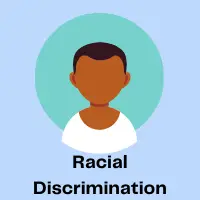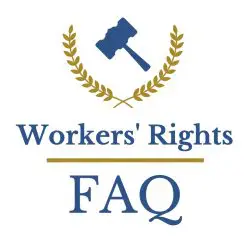What is Race and Color Discrimination?
Your questions about workers’ rights, answered

Race and color discrimination includes refusing to hire someone, treating an employee unfavorably, or firing someone because of their race or color.
Employers have a responsibility to create a workplace free from race and color discrimination. Employees are entitled to a discrimination-free working environment.
Keep reading to learn the definition of racial discrimination at work, what race and color discrimination refers to, and the difference between race and color discrimination.
Contact an employment lawyer to find out if you have a racial discrimination case.
What is the definition of race discrimination?
Race discrimination means treating a job applicant or employee unfavorably because of their race. The legal definition of racial discrimination at work includes mistreatment based on characteristics associated with race and discrimination because of an employee’s spouse.
Creating a hostile work environment because of racial harassment also qualifies as race discrimination.
Race discrimination violates the law and victims can sue for damages.
What is discrimination based on color?
Color discrimination means treating a job applicant or employee poorly because of the color of their skin. It can include discrimination based on the lightness or darkness of the employee’s skin or another color characteristic of the skin.
Refusing to hire qualified job applicants because of the color of their skin counts as color discrimination.
Discrimination laws prohibit color discrimination against everyone, including Caucasians.
What’s the difference between race and color?
Race and color may overlap, but they are not the same thing. Race refers to socially defined categories based on people’s background, while color refers to skin tone.
Discriminating against employees because of their race or color violates federal, state, and local laws.
What is the difference between race and color discrimination?
Racial discrimination at work means treating an employee poorly because of their race, while color discrimination means treating an employee poorly because of the color of their skin.
The two categories can overlap. While race and color are not the same, the same discrimination law protects against race and color discrimination. Both forms of discrimination violate the law.
What is considered race discrimination?
Race discrimination occurs if an employer treats a job applicant or employee badly because of their race. This can include refusing to hire members of a certain race, denying promotions because of an employee’s race, or firing someone because of their race.
It can also include discrimination because of an employee’s spouse or a characteristic associated with race.
Is there a difference between race and color discrimination?
Yes, race and color discrimination refer to two different types of illegal employment discrimination. Race discrimination means unfavorable treatment because of a job applicant or employee’s race, while color discrimination means unfavorable treatment because of the employee’s skin color.
Federal, state, and local laws protect employees of all races and colors from discrimination.
Does race discrimination involve emojis?
Harassing co-workers or subordinates with emojis can qualify as race discrimination. Creating a hostile work environment through harassment, including with emojis, violates race discrimination laws.
If a coworker attacks someone’s race, uses racial slurs, or makes offensive statements about a race, this can violate federal, state, and local discrimination laws.
What are the protected classes under Title VII?
Title VII of the Civil Rights Act of 1964 protects employees from discrimination based on sex, race, color, national origin, and religion.
These protected classes hold protections under federal law, and they can file an EEOC complaint if their employer violates their rights.
Additional laws, including state and local laws, also provide workplace discrimination protections for other groups.
What is the difference between race, color, and national origin discrimination?
Race discrimination means treating an employee or job applicant unfavorably because of their race. Color discrimination means unfavorable treatment because of skin color. National origin discrimination means unfavorable treatment because of the person’s country of origin.
Race, color, and national origin may overlap. Employers cannot discriminate against employees or job applicants because of their race, their skin color, or their national origin.
Which act prohibits discrimination on the basis of race only?
Section 1981 of the Civil Rights Act of 1866 prohibits discrimination on the basis of race. Several other acts also prohibit race discrimination, including Title VII of the Civil Rights Act of 1964.
Many state and local laws also target race discrimination. In New York, the New York Human Rights Law and the New York City Human Rights Law prohibit discrimination based on race or color.
Can I sue someone for discrimination?
Yes, you can file a lawsuit against an employer or potential employer for discrimination. Laws protect employees and job applicants from discrimination, including firing, being denied a promotion, or being denied an accommodation.
During a discrimination lawsuit, you can recover back pay, front pay, compensatory damages, and punitive damages. Victims of discrimination can also sue for emotional distress damages.
What is racial discrimination at work?
Racial discrimination occurs when an employer treats someone unfavorably because of their race.
Examples of racial discrimination include:
- Refusing to hire someone because of their race
- Denying raises or promotions because of race
- Creating a hostile work environment with racial harassment
Victims of racial discrimination can file a lawsuit to recover damages.
What is ethnic discrimination?
Ethnic discrimination means treating an employee or job applicant worse than other employees because of their ethnicity.
Federal, New York State, and New York City discrimination laws protect employees on the basis of race, color, national origin, and religion, which often covers ethnicity. Victims of ethnic discrimination can file a suit to recover damages.
What types of discrimination are there?
Workplace discrimination protects employees from unfavorable treatment because of their race, color, sex, age, and other characteristics.
Employers cannot discriminate against employees or job applicants, including in hiring, promotion, firing, or raises, because of someone’s membership in a protected category.
Discrimination also covers creating a hostile work environment because of harassment.
Learn more about common forms of workplace discrimination:
- Race Discrimination
- Gender Discrimination
- Religious Discrimination
- Age Discrimination
- Disability Discrimination
- Pregnancy Discrimination
- National Origin Discrimination
- LGBT Discrimination
- Transgender Discrimination
- Equal Pay and Wage Discrimination
How do you prove discrimination in court?
Victims of discrimination can provide evidence such as emails, letters, and communications with their supervisor or HR about the discrimination.
You can also keep records of the discrimination, make copies of performance evaluations, and keep records of any retaliation. Courts can also call witnesses to testify about the discrimination.
Contact an employment lawyer to learn more about how to prove a discrimination case.
What is race harassment?
Race harassment means targeted, offensive statements about a particular race. Race harassment in the workplace meets the definition of race discrimination if it creates a hostile work environment.
This harassment can include hostile comments, derogatory images, or offensive jokes. Employers have a responsibility to keep harassment out of the workplace.
What are the five protected classes?
Title VII of the Civil Rights Act of 1964 bans discrimination against five protected classes: race, color, sex, religion, and national origin.
Other federal, state, and local workplace discrimination laws also protect employees from discrimination on the basis of age, pregnancy, sexual orientation, disability, and other characteristics.
What are the EEOC protected classes?
At the federal level, the EEOC investigates claims of discrimination based on race, color, national origin, sex, religion, age, sexual orientation, and disability.
The EEOC also investigates acts of retaliation. In addition to federal protections, New York workers also have discrimination protections under state and New York City laws.
What employment discrimination laws protect New York City workers?
New York City workers benefit from employment discrimination protections under local, state, and federal law.
At the local level, the New York City Human Rights Law protects workers’ rights. At the state level, the New York Human Rights Law provides employment protections.
Several federal laws, including Title VII of the Civil Rights Act of 1964, the Equal Pay Act, and the Age Discrimination Act, also protect employees.
What is NYCHRL?
NYCHRL, or the New York City Human Rights Law, protects workers in New York from discrimination.
The law bans employment discrimination on the basis of race, color, sex, gender, sexual orientation, religion, national origin, age, caregiver status, pregnancy, and other protected categories.
Under NYCHRL, victims of workplace discrimination can file a claim against their employer.
What are the most common employment discrimination claims in New York?
In New York, the most common employment discrimination claims fall under race, sex, age, and religious discrimination. New York state and city law protects employees from discrimination on the basis of gender identity, sexual orientation, national origin, family status, and marital status.
Many discrimination claims also include retaliation or wrongful termination claims.
How do you file a complaint in New York?
Victims of race or color discrimination can file a complaint with the EEOC, the New York State Division of Human Rights, or the New York City Commission on Human Rights.
The three agencies cooperate in their investigations under a work-sharing agreement.
Victims of discrimination can also contact an employment lawyer for a free consultation.
What to do about race and color discrimination?
Victims of race and color discrimination can file a lawsuit against their employer. Learn more about race discrimination protections, discrimination laws, and potential damages.
A discrimination lawyer can help protect your rights.
If you’re in the greater New York City area, reach out to New York discrimination lawyer Charles Joseph for a free consultation. Charles Joseph brings over two decades of experience with workplace discrimination cases, and his firm has recovered over $140 million for clients.
Related FAQs
